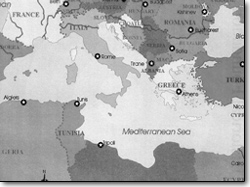|
|
||
|
Vege-terranean cuisine by Chef Boy Ari The 18 countries that touch the Mediterranean Sea belong to three different continents: Europe, Africa and Asia. What they have in common, aside from the Mediterranean’s turquoise water, are hot, dry summers and warm, wet winters. The people of the Mediterranean are made of olive, wheat, fish and grape. I recently attended a luncheon put on by culinary arts students, part of a weeklong workshop on Mediterranean and vegetarian cuisine. I caught up with Certified Executive Chef Tom Siegel, organizer of the event, and asked him about the logic of combining vegetarian and Mediterranean cuisines. “Mediterranean cuisine is primarily plant-based,” he explained. “They don’t have the land and climate to devote to heavy meat production, especially beef. The land is used largely for fruit, vegetables and grains. What meat there is comes from sheep – grazed in the barren, mountainous areas – and from the sea.” On Mediterranean tables, unlike those in the meat-and-potatoes U.S.A., it’s rare to see a slab of meat on a plate. If there is meat, it’s often integrated into the meal. Thus, Mediterranean recipes lend themselves to reducing meat or removing it altogether. “A typical Provence (France) dinner might be soup and an omelet,” Siegel explained. “Or take moussaka (Greek). Sometimes it’s made with eggplant and ground lamb, and sometimes just eggplant. The other day I made a test tray of moussaka with eggplant and seitan (a glutinous, protein-rich meat substitute derived from wheat). I did a taste test with a dozen culinarians from my staff, and they couldn’t tell the difference. The pan was gone in half an hour.” The things I learned that day kept piling up, from the origins of Mediterranean cuisine to the cutting edge of culinary vocabulary. Even my computer has never heard of the word “culinarian.” While the workshop was on Mediterranean and vegetarian cuisine, the luncheon that I attended featured the cuisine of Spain and Southern France. And let me tell you, those culinarians prepared quite a banquet. The buffet table was about 50 feet long, loaded with vegetarian and nonvegetarian paella, rabbit salmorejo (true to rabbit form, it tasted like chicken), Provencal fava bean ragout (wow), bouillabaisse w/rouille (a vegetable and shellfish soup, and another wow), Catalonian spinach (with raisins and pine nuts … wow again), and much more. When I got toward the end of the buffet table, my heart melted. There were two
When I got toward the end of the buffet table, my heart melted. There were two bowls of mayonnaise: one a garlic mayo called aioli, the other aioli with roasted red peppers blended in. One of the best things about mayonnaise is that it tastes good on everything. The man to my right had a nice dollop in his Bouillabaisse Rouille. The guy across the table had some on his Cassoulet de Touluose. The ladies to my left somehow abstained – none even upon the Tortilla Espagnola! Then came the ringer: chocolate pots de crème. This creamy, baked pudding tasted exactly how one would want such a thing to taste: the flavor of dark, rich chocolate somehow undiluted by the rich cream. Thickened and emulsified with egg yolks, it reminded me of a baked chocolate mayonnaise. Tom Siegel gave me a recipe for this blissful crème, which I tested in the lab. It’s vegetarian, though hardly vegan. I recommend it served with coffee. For this one, a kitchen scale really helps, but I will also indicate approximate volumes. A thermometer helps as well. This recipe serves eight. In a heavy pot or double boiler, slowly bring 2½ cups milk (or cream, or a combination thereof) and 1 cup sugar to a boil. Stir in 10 ounces (2½ cups) of dark or semisweet chocolate chips, and continue stirring until the mixture returns to a boil. Then kill the heat and allow to cool to 140 degrees. Now preheat the oven to 350 degrees. Then separate the yolks from 10 eggs and whisk them together with one whole egg. When the chocolate has cooled, slowly whisk it into the eggs, a little at a time. If the eggs start to curdle, the chocolate is too hot! Pour 4-ounce (3/4-cup) portions into cute little glass or ceramic cups. Place the cups in a baking pan with water deep enough to reach halfway up the cups. Bake 40 minutes at 350. Allow the cups to cool to room temperature. Then chill. As you spoon it into your mouth, close your eyes and imagine yourself a Greek god or goddess, gazing down from your mountaintop shrine upon the blue water, the sheep herds, the fields of wheat, the olive groves and the vineyards. And if your vision is good enough, watch the Arab caravans marching their camels across the desert, delivering cacao beans from sub-Saharan Africa to the Mediterranean shores. Then take another spoonful of your chocolate pots de crème and decide not to throw any lightning bolts that day. •
|
In this week's issue...
- May 15, 2025
- End of the trail
Despite tariff pause, Colorado bike company can’t hang on through supply chain chaos
- May 8, 2025
- Shared pain
Dismal trend highlights need to cut usage in Upper Basin, too
- April 24, 2025
- A tale of two bills
Nuclear gets all the hype, but optimizing infrastructure will have bigger impact


